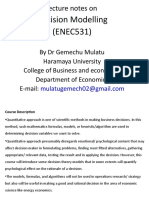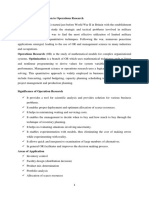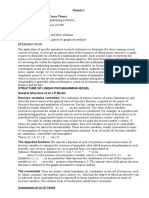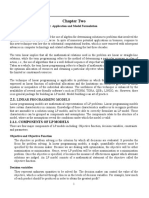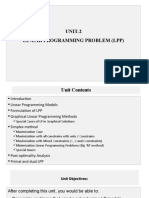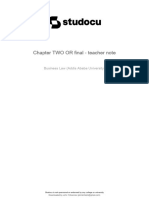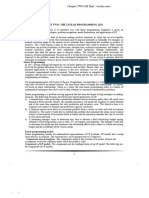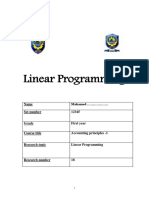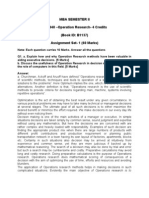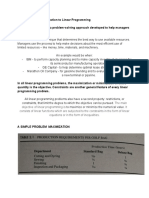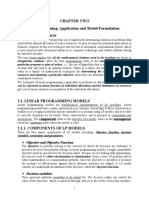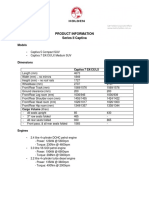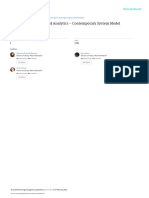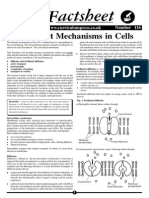chapter 3 Linear Programming
Uploaded by
Dejene Tsegayechapter 3 Linear Programming
Uploaded by
Dejene TsegayeResource Optimization in Construction 2017 E.
C
Chapter 3. Linear Programing
Resource optimization
In design, construction, and maintenance of any engineering system, engineers have to take many
technological and managerial decisions at several stages.
The ultimate goal of all such decisions is either to minimize the effort required or to maximize the
desired benefit.
Optimization
It can be defined as the process of finding the conditions (decision variables) that give the maximum or
minimum value of an objective function.
It is the science of choosing the best amongst a number of possible alternatives. It is the act of obtaining
the best result under given circumstances.
It is a process of finding the "best“(optimal) solution to a problem
What do we mean by the "best"?
The terminology „best‟ solution implies that there is more than one solution and the solutions are
not of equal value.
The cost, performance, aesthetics, quality, time, etc.
Optimization selects the "best" decision from a constrained situation.
• It is the process of adjusting the inputs to find the minimum or maximum output or result.
Optimizing Methods
The methods to find an optimal solution to the constrained resource scheduling problem fall into two
categories:
Mathematical programming or mathematical optimization, is a systematic approach used for
optimizing (minimizing or maximizing) the value of an objective function with
respect to a set of constraints
Enumeration is a common way to solve problems in computer programming. They involve listing
all possible solutions to a problem and checking each one to see if it's the best
solution.
3.1.Introduction Linear Programming (LP)
Linear means a fixed, definable relationship between the variables in the problem to be solved.
Programming refers to the orderly process by which this type of problem is solved.
Linear programming:-
In the context of operations research, LP can be defined as a mathematical tool that enables decision
makers to allocate limited resources amongst competing activities in an optimal manner in situations
where the problem can be expressed using a linear objective function and linear inequality constraints.
Addis College Department of Construction Technology and Management Page 1
Resource Optimization in Construction 2017 E.C
It concerns the optimization of a function of variables (i.e. the objective function), subject to a set of
linear equations and/or inequalities (i.e. constraints). It will find the minimum or maximum value of
the objective.
It is one of the most widely used a mathematical optimization technique in effective decision-making
that focuses on providing the optimal solution for allocating available resources amongst different
competing and conflicting requirements.
to help plan and make decisions relative to the trade-offs necessary to allocate resources.
to optimize performance (e.g. profit or cost) under a set of resource constraint (e.g. machine-hours,
man-hours, money, materials, etc.) as specified by an organization.
to find the best or optimal solution to a problem that requires a decision or set of decisions about how
best to use a set of limited resources to achieve a state goal of objectives.
to determine the optimum allocation of scarce resources among competing demands.
The objective function could be any measure of effectiveness such as cost, time, profit, capacity, etc., that
has to be achieved in the best possible way.
In constrained optimization, we have to optimize the objective function (or find the best value of the
function), keeping in mind the various constraints.
3.2. Assumptions underlying linear programming
Linear programming is based on several assumptions, including:
a) Proportionality: Changes in constraint inequalities will proportionally change the objective function.
b) Additivity: The total profit and resources used are the sum of the profit and resources used by each
product.
c) Divisibility: The fractional values of the decision variables are permitted.
d) Certainty: The parameters of the objective function coefficients and constraint inequalities are known
with certainty.
e) Finite choices: Decision variables are non-negative and the decision maker has certain choices.
f) Linearity: The relationship between the constraints and the objective function is linear.
Some limitations of linear programming include the assumption that all relations are linear, which may not
hold true for all situations.
3.3. Essentials of a Linear Programming model
For a given problem situation, there are certain essential conditions that need to be solved by using
Linear Programming.
1.Limited resources: limited number of labor, Space material, equipment and finance.
2.Objective: refers to the aim to optimize (maximize the profits or minimize the costs).
3.Linearity: increase in labor input will have a proportionate increase in output.
Addis College Department of Construction Technology and Management Page 2
Resource Optimization in Construction 2017 E.C
The linear model consists of the following components:
A set of decision variables
An objective function
A set of constraints
1. Decision Variables are physical quantities controlled by the decision maker and represented by
mathematical symbols. For example, the decision variable xj can represent the number of burrs of
product that a company will produce during some month. Decision variables take on any of a set of
possible values
2. Objective function defines the criterion for evaluating the solution. It is a mathematical function of the
decision variables that converts a solution into a numerical evaluation of that solution.
For example, the objective function may measure the profit or cost that occurs as a function of the
amounts of various products produced.
The objective function also specifies a direction of optimization, either to maximize or minimize.
An optimal solution for the model is the best solution as measured by that criterion.
3. Constraints are set of functional equalities or inequalities that represent physical, economic,
technological, legal, ethical, or other restrictions on what numerical values can be assigned to the
decision variables.
For example, constraints might ensure that no more input is used than is available.
Linear programming requires that all the mathematical functions in the model be linear functions.
A linear programming problem consists of a linear objective function to be maximized or
minimized subject to certain constraints in the form of linear equations or inequalities.
3.4. General statement of (LP) problems
The maximization or minimization of some quantity is the objective in all linear programming problems.
All (LP) problems have constraints that limit the degree to which the objective can be pursued.
A feasible solution satisfies all the problem's constraints.
An optimal solution is a feasible solution that results in the largest possible objective function value when
maximizing (or smallest when minimizing).
If both the objective function and the constraints are linear, the problem is referred to as a linear
programming problem.
Linear functions are functions in which each variable appears in a separate term raised to the first power
and is multiplied by a constant (which could be 0).
Linear constraints are linear functions that are restricted to be "less than or equal to", "equal to", or
"greater than or equal to" a constant.
Addis College Department of Construction Technology and Management Page 3
Resource Optimization in Construction 2017 E.C
3.5. Formulation of (LP) problems
Problem formulation or modeling is the process of translating a verbal statement of a problem into a
mathematical statement.
Formulating models is an art that can only be mastered with practice and experience.
Every (LP) problems has some unique features, but most problems also have common features
The Linear Programming Model
Let: Decision variables =X1, X2, X3, ………, X n
Objective function or linear function = Z
Requirement: Maximization of the linear function Z.
Z = c1X1 + c2X2 + c3X3 + ………+ c n X n ……………………………………………………Eq (1)
Subject to the following constraints:
…………………………………………………Eq (2)
Where aij, bi, and cj are given constants
Developing (LP) Model
Steps Involved:
Determine the objective of the problem and describe it by a criterion function in terms of the
decision variables.
Find out the constraints
Do the analysis which should lead to the selection of values for the decision variables that optimize
the criterion function while satisfying all the constraints imposed on the problem
3.6. Graphical method
The graphical method is used to solve simple linear programming problems having two decision variables.
The steps of graphical method for solving an LPP are as follows:
1. Plot the graph corresponding to the given constraints.
2. Determine the region for each given constraint.
3. Determine the feasible region
4. Determine corner/extreme points
5. Examine corner/extreme points
Addis College Department of Construction Technology and Management Page 4
Resource Optimization in Construction 2017 E.C
Example 1. A company manufactures two products, X and Y by using three machines A, B, and C.
Machine A has 4 hours of capacity available during the coming week. Similarly, the available capacity of
machines B and C during the coming week is 24 hours and 35 hours respectively. One unit of product X
requires one hour of Machine A , 3 hours of machine B and 10 hours of machine C. Similarly one unit
of product Y requires 1 hour, 8 hour and 7 hours of machine A, B and C respectively. When one unit of
X is sold in the market, it yields a profit of Birr 5 per product and that of Y is Birr 7 per unit. Solve the
problem by using graphical method to find the optimal product mix.
Solution: The details given in the problem is given in the table below:
Let the company manufactures x units of X and y units of Y, and then the L.P. model is:
Maximize Z = 5 x + 7 y
s.t.
1x+1y≤4
3 x + 8 y ≤ 24
10x + 7 y ≤ 35 and
Both x and y are ≥ 0.
Let us take machine A and find the boundary conditions. If x = 0, machine A can manufacture 4/1 = 4
units of y
(a) For machine A (b) For Machine B (c) For Machine C
Addis College Department of Construction Technology and Management Page 5
Resource Optimization in Construction 2017 E.C
Figure. Graph for machine A, B and C combined
Here we find the co-ordinates of corners of the closed polygon ROUVW and substitute the values in the
objective function. In maximization problem, we select the co-ordinates giving maximum value. And in
minimization problem, we select the co-ordinates, which gives minimum value.
In the problem the co-ordinates of the corners are:
R= (0, 3.5), O=(0,0), U= (3.5,0), V= (2.5, 1.5) and W=(1.6,2.4). Substituting these values in objective
function:
Z (0, 3.5) = 5×0 + 7×3.5 = Birr 24.50, at point R
Z(0,0)= 5× 0 + 7×0 = Birr 00.00, at point O
Z(3.5,0)= 5×3.5 + 7×0 = Birr 17.5 at point U
Z (2.5, 1.5)= 5 × 2.5 + 7 × 1.5 = Birr 23.00 at point V
Z (1.6, 2.4)= 5 × 1.6 + 7 × 2.4 = Birr 24.80 at point W
Hence the optimal solution for the problem is company has to manufacture 1.6 units of product X and 2.4
units of product Y, so that it can earn a maximum profit of Birr 24.80 in the planning period.
Example 2. In a manufacturing company, there are
constraints on the production of two types of
products, X and Y. The company can
produce a maximum of 40 units when
considering the combined production of X
and Y. Additionally, the production capacity
allows for a maximum of 60 units when
considering twice the production of X and
the production of Y. Each unit of X and Y
contributes to the overall profit, with X
contributing 8 units and Y contributing 1
unit. Determine the
Addis College Department of Construction Technology and Management Page 6
Resource Optimization in Construction 2017 E.C
Solution
Step 1: Objective function: Z = 8x + y
Step 2: Constraints are:
x + y ≤ 40
2x + y ≤ 60
x ≥ 0, y ≥ 0
Step 3: Draw the graph using these constraints.
x + y = 40 …(i)
2x + y = 60 …(ii)
Step 4: To find the maximum value of Z = 8x + y.
Compare each intersection point of the graph to find the maximum value of Z = 240 is at point x =
30, y = 0.
Example 3. One kind of cake requires 200 g of flour and 25g of fat, and another kind of cake requires 100
g of flour and 50 g of fat. Find the maximum number of cakes that can be made from 5 kg of flour and 1 kg
of fat assuming that there is no shortage of the other ingredients, used in making the cakes.
Step 1: Create a table like this for easy understanding
Step 2: Constraints are:
• 200x + 100y ≤ 5000 or 2x + y ≤ 50
• 25x + 50y ≤ 1000 or x + 2y ≤ 40
Also, x > 0 and y > 0
Step 3: Objective function:
• Z= x+y
Step 4: Create a graph using the constraints.
• 2x + y = 50
• x + 2y = 40
•x=0
•y=0
Step 5: To find the maximum number of cakes (Z) = x + y.
Compare each intersection point of the graph to find the maximum number of cakes that can be
baked.
Addis College Department of Construction Technology and Management Page 7
Resource Optimization in Construction 2017 E.C
Clearly, Z is maximum at co-ordinate (20, 10). So the maximum number of cakes that can be baked
is Z = 20 + 10 = 30
Example 4. A Production Problem
Mugger cement manufacture wishes to produce two types of cement: type-A will result in a profit of
10.00 birr, and type-B in a profit of 12.00 birr. To manufacture a Type-A cement requires 20 minutes on
machine I and 10 minute on machine II. Type-B cement requires 10 minute on machine I and 30 minutes
on machine II. There are 3 hours available on machine I and 5 hours available on machine II.
Formulate a linear programming model
How many cement of each type should Mugger cement make in order to maximize its profit?
Solution
Given information
Type A Type B Time Available
Profit/Unit 10 Birr 12 Birr
Machine I 20 min. 10 min. 180 min,
Machine II 10 min. 30 min, 300 min.
Let X1 be the number of type-A cement and X2 the number of type-B cement to be made
Then, the total profit (in birr) is given by which is the objective function to be maximized
Z = 10X1+12X2
The total amount of time that machine I is used is 20X1+10X2 and must not exceed 180 minutes.
Thus, we have the inequality: - 20X1+10X2 ≤ 180 ( 1St constraint) .
The total amount of time that machine II is used is 10X1+30X2 and must not exceed 300 minutes.
Thus, we have the inequality: - 10X1+30X2 ≤ 300 ( 2nd constraint)
Finally, X1 and X2 can not be negative, so X1 > 0 (non- negative constraint) and X2 > 0 (non- negative
constraint)
In short, we want to maximize the objective function
Z = 10X1+12X2
subject to the system of inequalities
10X1+20X2 ≤ 180
10X1+30X2 ≤ 300
X1> 0
X2> 0
Example 5. Maximizing Profit
How many bowls and mugs should be produced to maximize profits given labor and materials
constraints?( formulate a linear programming model) for 40 hrs of labor per day and 120 lbs of clay
Given product resource requirements and unit profit:
Addis College Department of Construction Technology and Management Page 8
Resource Optimization in Construction 2017 E.C
Resource Availability: 40 hrs of labor per day, 120 lbs of clay
Decision Variables:
X1 = number of bowls to produce per day
X2 = number of mugs to produce per day
Objective Function: Maximize Z = $40 X 1 + $50 X 2,
Where Z = profit per day
Resource Constraints:
1X1 + 2 X 2 ≤ 40 hours of labor
4X1 + 3X2 ≤ 120 pounds of clay
Non-Negativity Constraints: X1 ≥ 0; X2 ≥ 0
Complete Linear Programming Model:
Maximize Z = $40X1 + $50 X2
Subject to: 1X1 + 2X2 ≤ 40
4X1 + 3X2 ≤ 120
X1, X2≥0
Example 6. A small company produces construction materials for the commercial and residential
construction industry. The company produces two products: a universal concrete patching
product (CON) and a decorative brick mortar (MORT). The company can sell the CON for a
profit of $ 140/ton and the MORT for a profit of $160/ton. Each ton of the CON requires 2 m3
of the red clay and each ton produced of the MORT requires 4 m3. A maximum of 28 m3 of the
red clay could be available every week. The machine used to blend these products can work
only a maximum of 50 hours per week. This machine blends a ton of either product at a time,
and the blending process requires 5 hours to complete. Each material must be stored in a
separate curing vat, thus limiting the overall production volume of each product. The curing
vats for CON and MORT have capacities of 8 and 6 tons, respectively. What is optimal
production strategy for the company given this information?
Solution Model Formulation
Decision Variables
Amounts of CON and MORT produced every week
Let X1= amount of CON produced every week
X2 = amount of MORT produced every week
Addis College Department of Construction Technology and Management Page 9
Resource Optimization in Construction 2017 E.C
Objective Function
• To maximize the profit obtained from the production of the two material per week
• Every tone of CON earns $140profit
• Every tone of MORTearns $160 profit
• Objective function
Maximize total weekly profit, 𝑍 = 140 X1 + 160 X2
• Constraints
Red clay required to produce a ton of CON is 2 m3
Red clay required to produce a ton of MORT is 4 m3
Total available red clay every week is 28 m3
1st Constraint: 2 X1 + 4X2 ≤ 28
Blending of each ton requires 5 hours at a time for each production and per week a maximum of 50
hours of production is possible
2nd Constraint: 5X1 + 5X2 ≤ 50
Curing vats capacity is 8 tons for CON and 6 tons for Mortar
3rd Constraint: X1 ≤ 8
4th Constraint: X2 ≤ 6
Maximize 𝑍 = 140𝑥1 + 160𝑥2
Subject to
2𝑥 + 4𝑥 ≤ 28
5𝑥1 + 5𝑥2 ≤ 50
𝑥1 ≤ 8
𝑥2 ≤ 6
Example 7. A company produces two types of tables; Tables A and Table B. It takes 2 hours of cutting
time and 4 hours of assembling to produce Table A. It takes 10 hours of cutting time and 3
hours of assembling to produce Table B. The company has at most 112 hours of cutting labor
and 54 hours of assembly labor per week. The company's profit is Birr 60 for each Table A
produced and Birr 170 for each Table B produced. How many of each type of table should the
company produce in order to maximize profit?
Example 8. A furniture company makes tables and chairs. To produce a table it requires 2 hrs. on machine
A, and 4 hrs. on machine B. To produce a chair it requires 3 hrs. on machine A and 2 hrs. on
machine B. Machine A can operate at most 12 hrs. a day and machine B can operate at most 16
hrs. a day. If the company makes a profit of Birr 12 on a table and Birr 10 on a chair, how
many of each should be produced to maximize its profit?
Addis College Department of Construction Technology and Management Page 10
Resource Optimization in Construction 2017 E.C
Solution: Let x be the number of tables to be produced and y be the number of chairs to be
produced. Then, if a table is produced in 2 hrs on machine A, x tables requires 2x hrs. Similarly, y
chairs require 3y hrs on machine A. On machine B, x tables require 4x hrs and y chairs require 2y
hrs. Since machines A and B can operate at most 12 hrs and 16 hrs, respectively, you have the
following system of linear inequalities.
From machine A: 2x + 3y 12
From machine B: 4x + 2y 16
Also, x ≥0 and y ≥0 since x and y are numbers of tables and chairs. Hence, you obtain a system of
linear inequalities given as follows:
𝑥
𝑥
{
𝑥
Exercise 1. A concrete manufacturer is concerned about how many units of two types of concrete elements
should be produced during the next time period to maximize profit. Each concrete element of
type “A” generates a profit of $60, while each element of type “B” produces a profit of $40.
Two and three units of raw materials are needed to produce one concrete element of type A and
B, respectively. Also, four and two units of time are required to produce one concrete element
of type A and B respectively. If 100 units of raw materials and 120 units of time are available.
Formulate a linear programming model for this problem to determine how many units of each
type of concrete elements should be produced to maximize profit.
Exercise 2. A firm is engaged in producing two products, A and B. Each unit of product A requires 2 kg of
row material and 4 labor hours for processing, whereas each unit of product B requires 3 kg of
row material and 3 hours of labor of the same type. Every week, the firm has an availability of
60 kg of row material and 90 labor hours .One unit of product A sold yields 40 birr and one
unit of product B sold give 35 birr as profit .Formulate this problem as L(LP) to determine as
to how many unit of each of the product should be produced per week so that the firm can earn
the maximum profit. Assume that there is no marketing constraint so that all that is produced
can be sold.
Exercise 3. A contractor may purchase material from two different sand and gravel pits. The unit cost of
material including delivery from pits 1 and 2 is $50 and $70 per cubic meter, respectively, the
contractor requires at least 100 cubic meter of mix. The mix must contain a minimum of 30%
sand. Pit 1 contains 25% and pit 2 contains 50% sand. If the objective is to minimize the cost
of material, define the decision variables and formulate a mathematical model.
Addis College Department of Construction Technology and Management Page 11
Resource Optimization in Construction 2017 E.C
3.7. Some special cases of (LP)
Four special cases and difficulties arise at times when using the graphical approach to solving LP
problems: (1) infeasibility, (2) unboundedness, (3) redundancy, and (4) alternate optimal solutions.
a) Infeasible Problem Linear Programming (LP)
In some cases, there is no feasible solution area, i.e., there are no points that satisfy all constraints of the
problem. An infeasible LP problem with two decision variables can be identified through its graph. For
example, let us consider the following linear programming problem (LPP).
Minimize z = 200x1 + 300x2
Subject to
o 2x1 + 3x2 ≥ 1200
o x1 + x2 ≤ 400
o 2x1 + 1.5x2 ≥ 900
o x1, x2 ≥ 0
The region located on the right of PQR includes all solutions, which satisfy the first and the third
constraints. The region located on the left of ST includes all solutions, which satisfy the second constraint.
Thus, the problem is infeasible because there is no set of points that satisfy all the three constraints.
b) Unbounded Solution: Graphical Method in LPP
It is a solution whose objective function is infinite. If the feasible region is unbounded then one or more
decision variables will increase indefinitely without violating feasibility, and the value of the objective
function can be made arbitrarily large. Consider the following model:
Minimize z = 40x1 + 60x2
Subject to
o 2x1 + x2 ≥ 70
o x1+ x2 ≥ 40
o x1 + 3x2 ≥ 90
o x1, x2 ≥ 0
The point (x1, x2) must be somewhere in the solution space as shown in the figure by shaded portion. The
three extreme points (corner points) in the finite plane are: P= (90, 0); Q= (24, 22) and R= (0, 70). The
values of the objective function at these extreme points are: Z (P) =3600, Z (Q) =2280 and Z(R) = 4200
Addis College Department of Construction Technology and Management Page 12
Resource Optimization in Construction 2017 E.C
In this case, no maximum of the objective function exists because the region has no boundary for
increasing values of x1 and x2. Thus, it is not possible to maximize the objective function in this case and
the solution is unbounded.
c) Redundancy/ Degeneracy
Redundant constraints imply constraints that can be deleted or excluded from the linear constraints
arrangement and have no impact on the feasible solution. For instance, if two constraints in an LP problem
are: x + 6 y ≥ 36 and 2 x + 12 y ≥ 72.
A redundant constraint is one that does not affect the feasible solution region.
Maximize Z=80X1+70X2
Subject to
o 2X1+X2 ≤ 120
o X1+X2 ≤ 60
o X1≤ 70
o x1, x2 ≥ 0
d) Alternate optimal solutions- LP problem has more than one optimal solution
o This is the case when the objective function‟s isoprofit of isocost line runs perfectly parallel to one of
the problem‟s constraint.
o Provide greater flexibility to the decision maker.
o Example
Maximize Z=60X1+60X2
Subject to
o 3X1+3X2≤90
o 2X1+4X2≤80
o X1, X2 ≥ 0
o Two corner points having the same maximum value indicate the LP problem has alternate optimal
solution.
Addis College Department of Construction Technology and Management Page 13
You might also like
- Additive Manufacturing of Ceramics and Cermets: Present Status and Future PerspectivesNo ratings yetAdditive Manufacturing of Ceramics and Cermets: Present Status and Future Perspectives35 pages
- Chapter One: Introduction To Operations Research Operations ResearchNo ratings yetChapter One: Introduction To Operations Research Operations Research45 pages
- Unit I Operation Research Introduction: Characteristics of Operations ResearchNo ratings yetUnit I Operation Research Introduction: Characteristics of Operations Research90 pages
- Unit Three Intro. to Linear Programming 1No ratings yetUnit Three Intro. to Linear Programming 118 pages
- Application of Linear Programming in Multi-Design Selection: Mee-Edoiye M. AndaweiNo ratings yetApplication of Linear Programming in Multi-Design Selection: Mee-Edoiye M. Andawei4 pages
- Dr. R K Singh Professor, Operations Management Management Development Institute, Gurgaon100% (1)Dr. R K Singh Professor, Operations Management Management Development Institute, Gurgaon106 pages
- Mba Semester Ii MB0048 - Operation Research-4 Credits (Book ID: B1137) Assignment Set - 1 (60 Marks)No ratings yetMba Semester Ii MB0048 - Operation Research-4 Credits (Book ID: B1137) Assignment Set - 1 (60 Marks)20 pages
- LPP Project - Profit Maximization Through Optimization Technique100% (2)LPP Project - Profit Maximization Through Optimization Technique38 pages
- CHAPTER 6 System Techniques in Water Resuorce PPT Yadesa100% (1)CHAPTER 6 System Techniques in Water Resuorce PPT Yadesa32 pages
- Chapter-5-transportation-and-assignment-modelsNo ratings yetChapter-5-transportation-and-assignment-models29 pages
- chapter 5 Transportation and Assignment ProblemsNo ratings yetchapter 5 Transportation and Assignment Problems49 pages
- Chapter-4 Linear Programing Simplex - CopyNo ratings yetChapter-4 Linear Programing Simplex - Copy76 pages
- Contract specification and Quantity Surveying Question Paper 2016100% (1)Contract specification and Quantity Surveying Question Paper 20162 pages
- Download Complete EASA Module 11A B1 Turbine Aeroplane Aerodynamics Structures and Systems 4th Edition Aircraft Technical Book Company Llc PDF for All Chapters100% (4)Download Complete EASA Module 11A B1 Turbine Aeroplane Aerodynamics Structures and Systems 4th Edition Aircraft Technical Book Company Llc PDF for All Chapters55 pages
- P.T. Stanvac Indonesia P.T. Schlumberger Geophysics: NusantaraNo ratings yetP.T. Stanvac Indonesia P.T. Schlumberger Geophysics: Nusantara16 pages
- Fast Combinational Architecture For A Vedic DividerNo ratings yetFast Combinational Architecture For A Vedic Divider5 pages
- WD Elements Portable SE Specifications (English)No ratings yetWD Elements Portable SE Specifications (English)2 pages
- Earth Resistivity Measurement Interpretation TechniquesNo ratings yetEarth Resistivity Measurement Interpretation Techniques9 pages
- Introduction To Java Programming Comprehensive Version 9th Edition Liang Test Bank100% (33)Introduction To Java Programming Comprehensive Version 9th Edition Liang Test Bank7 pages
- [FREE PDF sample] CURRENT Diagnosis Treatment Gastroenterology Hepatology Endoscopy 1st Edition Norton Greenberger ebooksNo ratings yet[FREE PDF sample] CURRENT Diagnosis Treatment Gastroenterology Hepatology Endoscopy 1st Edition Norton Greenberger ebooks67 pages
- Interest Rate Futures and Options OpenGammaNo ratings yetInterest Rate Futures and Options OpenGamma7 pages
- Additive Manufacturing of Ceramics and Cermets: Present Status and Future PerspectivesAdditive Manufacturing of Ceramics and Cermets: Present Status and Future Perspectives
- Chapter One: Introduction To Operations Research Operations ResearchChapter One: Introduction To Operations Research Operations Research
- Unit I Operation Research Introduction: Characteristics of Operations ResearchUnit I Operation Research Introduction: Characteristics of Operations Research
- Application of Linear Programming in Multi-Design Selection: Mee-Edoiye M. AndaweiApplication of Linear Programming in Multi-Design Selection: Mee-Edoiye M. Andawei
- Dr. R K Singh Professor, Operations Management Management Development Institute, GurgaonDr. R K Singh Professor, Operations Management Management Development Institute, Gurgaon
- Mba Semester Ii MB0048 - Operation Research-4 Credits (Book ID: B1137) Assignment Set - 1 (60 Marks)Mba Semester Ii MB0048 - Operation Research-4 Credits (Book ID: B1137) Assignment Set - 1 (60 Marks)
- LPP Project - Profit Maximization Through Optimization TechniqueLPP Project - Profit Maximization Through Optimization Technique
- CHAPTER 6 System Techniques in Water Resuorce PPT YadesaCHAPTER 6 System Techniques in Water Resuorce PPT Yadesa
- Random Optimization: Fundamentals and ApplicationsFrom EverandRandom Optimization: Fundamentals and Applications
- Mathematical Optimization: Fundamentals and ApplicationsFrom EverandMathematical Optimization: Fundamentals and Applications
- Contract specification and Quantity Surveying Question Paper 2016Contract specification and Quantity Surveying Question Paper 2016
- Download Complete EASA Module 11A B1 Turbine Aeroplane Aerodynamics Structures and Systems 4th Edition Aircraft Technical Book Company Llc PDF for All ChaptersDownload Complete EASA Module 11A B1 Turbine Aeroplane Aerodynamics Structures and Systems 4th Edition Aircraft Technical Book Company Llc PDF for All Chapters
- P.T. Stanvac Indonesia P.T. Schlumberger Geophysics: NusantaraP.T. Stanvac Indonesia P.T. Schlumberger Geophysics: Nusantara
- Fast Combinational Architecture For A Vedic DividerFast Combinational Architecture For A Vedic Divider
- Earth Resistivity Measurement Interpretation TechniquesEarth Resistivity Measurement Interpretation Techniques
- Introduction To Java Programming Comprehensive Version 9th Edition Liang Test BankIntroduction To Java Programming Comprehensive Version 9th Edition Liang Test Bank
- [FREE PDF sample] CURRENT Diagnosis Treatment Gastroenterology Hepatology Endoscopy 1st Edition Norton Greenberger ebooks[FREE PDF sample] CURRENT Diagnosis Treatment Gastroenterology Hepatology Endoscopy 1st Edition Norton Greenberger ebooks














